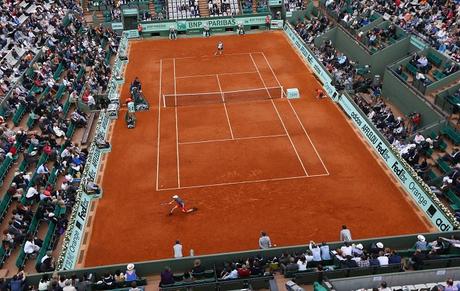
Since the French Open is around the corner (May 16 - June 5), I thought I'd share my first clay court experience with you, as well as some great tips and strategies that I've learned since :-)
Once upon a time, I was a clay court virgin. I had only ever seen a clay court on my TV and from a distance at a few of the clubs I've played. But that all changed 8 years ago when I played in the Oakbourne Crawfish Classic.
Now, this wasn't the first time I had played in this tournament, but the third, so the fact that Oakbourne uses courts at three different locations to accommodate all of the teams was no surprise. I, myself, had payed at two of the locations, and loved every minute of it, playing on those beautiful hard courts. So you can imagine the sheer horror when, for this particular tournament, my team and I arrive at the third location and find that our first match was to be played on clay courts. What fresh tennis-Hell is this?! We were like:
It was 11:15 am, and another team was just finishing their match. The clay was loose and piled up all over court from players running about and sliding. Were they at least going to smooth the surface and spray it down before we play? (Nope.) I could just picture all the bad bounces the balls were going to make. Not only that, but we have only our regular court shoes. Is this like bowling, and we rent a pair of clay court shoes? (Nope.) And to make matters worse, the miles of bleachers were packed with spectators, no doubt the other teams either waiting to play or those who have just finished up. Oh Lord, take me now!
My partner and I tried our best to get used to the court's intimidating surface as we walked to the end post to put down our gear and meet our opponents - identical twins. Not only are they wearing the same outfit, but one is a lefty (which one? I don't know, they're freakin' identical twins!) - and they "love playing on clay." We are so screwed.
Playing tennis on that court felt like playing tennis in a litter box. It was"crunchy" and uneven, and if I had to run down a ball, there was an 85% chance of slipping and falling on my face (or ass) when I tried to stop. Seriously, if you don't know what to expect when "sliding", (and we didn't) it's almost like having the rug pulled out from under you. It was an America's Funniest Home Videos wet dream.
Needless to say, it was a very quick match... And we lost. BADLY.
We played 2 more matches that weekend, winning them both, so at least went home, a little bruised but feeling somewhat redeemed. It was then that I made a promise to myself to learn how to play on clay, so that the next time I encountered such a court, I would be ready!
Since my club doesn't have clay courts, I took lessons at another one, along with two of my team mates. We learned how to slide, which was VERY different from what we had done previously, lol! We also learned some key fundamentals and strategies which helped the following year when we played in the Oakbourne tournament again. We still lost, but not by much, AND our egos were still intact - a HUGE improvement!
If you've never played on clay before and want to, or if you could use a refresher, here are 7 really good tips and strategies, including an instructional video on how to slide, from the awesome guys at TopTennisTraining.com
Wear the right tennis shoe for clay surfaces. The outsole of a clay court shoe will usually feature a full herringbone (the zig zags) tread pattern which will keep the clay from clogging the tread, so you can get a better grip when you try to start, stop or change directions.
Learn to slide on clay [Video Instruction]. The clay surface is different from the other surfaces in footing as well as bounce. Being able to slide effectively on clay will allow you to get to balls you would not have a chance at on harder surfaces.
Mix up your shots. Since the clay surface slows down the hard shots, play requires a little creativity. Use different spins and angles instead of just trying to hit it hard. The element of surprise is your best friend on clay courts.
Put topspin on your shots. Topspin works well on clay because the spin bites into the clay well, giving it a more unpredictable bounce, and it will make it difficult for your opponent to put counter spin on it.
Hit deep into the court. Playing deep will allow you more time to plan your shots since clay is slower. This will also allow you to play offensively rather than defensively, so you'll have more control over the point.
Be patient. Because clay tennis courts play slower than other surfaces, points usually last longer. Clay courts don't produce a lot of winners (except from the pros) so good conditioning is essential since you will be moving back and forth a lot.
Make your opponents back up and hit them with a drop shot. Drop shots can be devastating on clay. Mixed in with deep balls that have lots of topspin, drop shots can give you a great advantage.
Though my first time wasn't magical, and the earth didn't move, the experience motivated me to learn to play the game I love on a totally new surface. Now I really enjoy clay court play!


